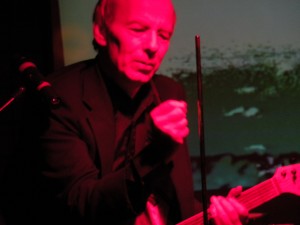ERIC ROSS BRINGS HIS UNIQUE TALENTS TO L.A. WITH ULTIMEDIA THEREMIN AT REDCAT
You may not know the Theremin by name but if you have ever seen a horror film or listened to the Beach Boys Good Vibrations you have undoubtedly been wowed by its unusual and often eerie and other-worldly sound. It is without question a one-of-a-kind musical instrument. Invented by Professor Leon Theremin in 1928, it’s basically two metal antennas that sense the position of the musicians hands with no actual physical contact. That’s right, an instrument you play without touching it. Only a few have truly mastered the art of the Theremin and Los Angelinos will get the rare opportunity to experience a world class performance when virtuoso Eric Ross brings its hypnotic and lyrical magic to REDCAT on Friday, November 2, 2012. Mr. Ross, an innovative multi-instrumentalist and composer will be teaming up with his wife, world renown video artist and photographer Mary Ross, for Ultimedia Theremin, a dynamic mix of innovative visual and musical styles that is sure to be an engrossing and memorable evening. Stage and Cinema landed some talk time with Mr. Ross soon after he landed and was settling in to his temporary Santa Barbara digs in preparation for the big show.
Stage and Cinema: Welcome to La-La-Land. Where did you fly in from?
Eric Ross: New York.
S&C: You got out just in time before they closed all the airports in anticipation of hurricane Sandy.
ER: Yeah I know it. Just in time. Oh man. No, I’m sitting here looking at the sun and the sea—this is the life.
S&C: Well I’m glad you made it. How did you first get interested in the Theremin? It’s such an unusual instrument.
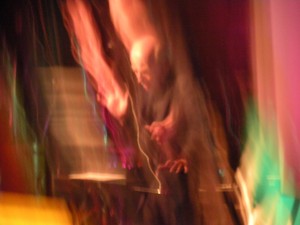 ER: Well I had gotten involved in electronic music in about the mid-70’s. I started on the Moog analogue synthesizer while in Upstate New York. And of course Bob Moog was around, and he started out building Theremins. That’s how he got into building a synthesizer. So it seemed like kind of a natural extension. I had some engineers at the studio I was working in put one together for me. I quickly realized it was difficult to play and a serious instrument, but after a number of years, I was able to get some stuff going with it. I used it on my first recording in 1982, an album called Songs for a Synthesized Soprano. That really was a big break for me. After it got out, it enabled me to meet a lot of other musicians. A lot of people picked up on it. I know Miles Davis had it and John McLaughlin and B.B. King—because I think it was something unusual at that time. Since then I’ve just really kept on, and it’s led me to a lot of different areas where I have met a lot of different people. The Theremin is just a unique kind of thing.
ER: Well I had gotten involved in electronic music in about the mid-70’s. I started on the Moog analogue synthesizer while in Upstate New York. And of course Bob Moog was around, and he started out building Theremins. That’s how he got into building a synthesizer. So it seemed like kind of a natural extension. I had some engineers at the studio I was working in put one together for me. I quickly realized it was difficult to play and a serious instrument, but after a number of years, I was able to get some stuff going with it. I used it on my first recording in 1982, an album called Songs for a Synthesized Soprano. That really was a big break for me. After it got out, it enabled me to meet a lot of other musicians. A lot of people picked up on it. I know Miles Davis had it and John McLaughlin and B.B. King—because I think it was something unusual at that time. Since then I’ve just really kept on, and it’s led me to a lot of different areas where I have met a lot of different people. The Theremin is just a unique kind of thing.
S&C: Well it certainly has a unique look. When you see it, you think that it can’t possibly be an instrument. Did it take you a long time to master it?
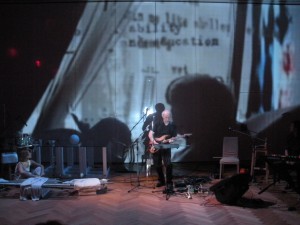 ER: Well, it’s really very difficult to play. I mean to play it seriously. Yeah, I would say probably five or six years before I was able to get some real musical results from it. Once I got the feel of it, I decided that this was such a beautiful instrument that I had to stay with it. 1982 was an important year for me because that was the year I met Clara Rockmore, who was the greatest virtuoso of the Theremin. She had used it to play basically a classical repertory—and I was more interested in it for new music and jazz and that sort of thing—but she was really an encouragement and inspiration to me. Through Clara, I was able to meet Bob Moog and, a few years later, Professor Theremin himself in New York, who I played for during the making of the movie Theremin: An Electronic Odyssey. I would say those three people were my main inspirations with the instrument; they were very encouraging. While Clara was more interested in the classical, they were also very interested in developing a new repertory for the Theremin. They were very interested and supportive of me and it really helped me to keep going. As I said, a lot of people who have used the Theremin in the past have either used it for one of two things: Either classical repertory or special effects. Of course the most common use of it was in Hollywood horror movies. Clara Rockmore never did any of those movies. They had asked her at times to do some scores but she said no. She wanted to keep the Theremin as a serious instrument, not as just a gimmick or special effect. She felt it had a real place as a serious instrument and I’ve tried to maintain that attitude myself. I try to keep it as a serious instrument in whatever context I use it in.
ER: Well, it’s really very difficult to play. I mean to play it seriously. Yeah, I would say probably five or six years before I was able to get some real musical results from it. Once I got the feel of it, I decided that this was such a beautiful instrument that I had to stay with it. 1982 was an important year for me because that was the year I met Clara Rockmore, who was the greatest virtuoso of the Theremin. She had used it to play basically a classical repertory—and I was more interested in it for new music and jazz and that sort of thing—but she was really an encouragement and inspiration to me. Through Clara, I was able to meet Bob Moog and, a few years later, Professor Theremin himself in New York, who I played for during the making of the movie Theremin: An Electronic Odyssey. I would say those three people were my main inspirations with the instrument; they were very encouraging. While Clara was more interested in the classical, they were also very interested in developing a new repertory for the Theremin. They were very interested and supportive of me and it really helped me to keep going. As I said, a lot of people who have used the Theremin in the past have either used it for one of two things: Either classical repertory or special effects. Of course the most common use of it was in Hollywood horror movies. Clara Rockmore never did any of those movies. They had asked her at times to do some scores but she said no. She wanted to keep the Theremin as a serious instrument, not as just a gimmick or special effect. She felt it had a real place as a serious instrument and I’ve tried to maintain that attitude myself. I try to keep it as a serious instrument in whatever context I use it in.
S&C: Clara Rockmore was prominently featured in the documentary.
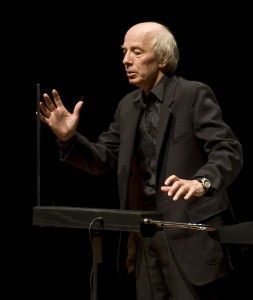 ER: Correct. That’s a movie that was made by Steven M. Martin who is out here in Hollywood. That’s how I got to meet Professor Theremin himself: Steve called me one day and said if I wanted to meet the Professor, he had him in the Mayfair Hotel in NYC and I should come on over. So I went over and we filmed about 15 minutes of me playing, and then him playing. One thing that really got his interest was when I put my Theremin through a wah-wah pedal, which is a guitar effect, and I played it. That really got his attention because he had never heard anything like that. Then he tried it himself and he really liked it. He was a fascinating man and if you saw the movie than you know a little bit about the political background of his life—having to endure Stalin’s Russia and all that. He was still very creative and involved at 91 or 92 at that time. He told me he was working on a polyphonic Theremin, a Theremin that could play chords. Right up until the end of his life he stayed creative and involved in music.
ER: Correct. That’s a movie that was made by Steven M. Martin who is out here in Hollywood. That’s how I got to meet Professor Theremin himself: Steve called me one day and said if I wanted to meet the Professor, he had him in the Mayfair Hotel in NYC and I should come on over. So I went over and we filmed about 15 minutes of me playing, and then him playing. One thing that really got his interest was when I put my Theremin through a wah-wah pedal, which is a guitar effect, and I played it. That really got his attention because he had never heard anything like that. Then he tried it himself and he really liked it. He was a fascinating man and if you saw the movie than you know a little bit about the political background of his life—having to endure Stalin’s Russia and all that. He was still very creative and involved at 91 or 92 at that time. He told me he was working on a polyphonic Theremin, a Theremin that could play chords. Right up until the end of his life he stayed creative and involved in music.
S&C: You have a very wide and varied musical background. Everything from classical to jazz to…
ER: …new music, avant-garde, non-Western, rock, blues, all kinds of different styles. But the Theremin is the thing that has led me into all these different areas.
S&C: For the concert on Friday night will you be exclusively playing the Theremin or will you be incorporating other instruments as well?
ER: Well, I also play guitar, synthesizer, and keyboards. Playing the guitar is one of the most rewarding experiences you can have. I’ll be using those in the concert as well—along with my wife’s videos. My wife, Mary Ross, is a video artist and photographer. She does the videos for this performance with kind of a multi-media presentation.
S&C: How long have you two been collaborating?
ER: At least since the early 80’s. She was interested in primary video synthesis, which was image processing in terms of colorizing and keying. She’s been doing that even before MTV. It just seemed natural that we would collaborate and do these multi-media presentations.
S&C: The primary piece you will be performing on Friday is Boulevard d’Ronstructie (Op. 54).
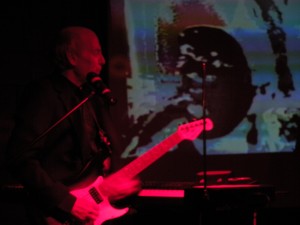 ER: Yes, that’s our newest piece. I think it’s a piece in which the synergy between the two of us really comes together. I’ve taken themes and ideas and she’s taken themes and images from our whole career from the 80’s and 90’s and 2000’s. We’ve put them together into what you might call a surrealistic biographical way. I think of it like the way the memory works, in that you can have a memory from 1982 alongside a memory from something you did yesterday and then there’s another memory from something further back. All these layers in your memory and in your mind get compressed and put together and mixed and that’s kind of the idea of this. These things exist in our minds simultaneously.
ER: Yes, that’s our newest piece. I think it’s a piece in which the synergy between the two of us really comes together. I’ve taken themes and ideas and she’s taken themes and images from our whole career from the 80’s and 90’s and 2000’s. We’ve put them together into what you might call a surrealistic biographical way. I think of it like the way the memory works, in that you can have a memory from 1982 alongside a memory from something you did yesterday and then there’s another memory from something further back. All these layers in your memory and in your mind get compressed and put together and mixed and that’s kind of the idea of this. These things exist in our minds simultaneously.
S&C: Is the first time you’re playing REDCAT?
ER: Yes. And it’s actually only the second time I’ve played in California. I was out in Sacramento last year and played at the university. I am really happy to be back here. The people who are bringing us in said, “Well, this is something different.”
S&C: That’s putting it lightly. I know I’m looking forward to seeing the show.
ER: It should be nice. Stop by and say hello.
photos courtesy of the artists
Ultimedia Theremin with Eric and Mary Ross
REDCAT (Roy and Edna Disney/CalArts Theatre) in Los Angeles
Friday, November 2, 2012 8:30pm
General admission $20 (students and members $16)
for tickets, call (213) 237-2800 or visit http://www.redcat.org
for Eric Ross tour info, visit http://www.ericross.info/
for Mary Ross photo info, visit http://www.maryross.info/
